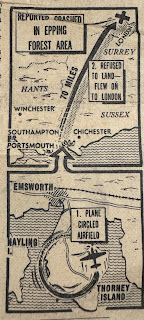At low tide two Second World War era shipwrecks are visible in Woodspring Bay, to the west of the village of Kingston Seymour. Indeed they are visible for walkers covering my Clevedon Military History trail which can be accessed here. Although the coast is not easily accessed in direct proximity to the wrecks, I had the pleasure of spending a day with three local farmers who share my passion for history and were an encyclopedia of knowledge about the impact of the war on this fascinating spot on the North Somerset coast.
 |
| HMS Fernwood and HMS Staghound |
Apparently it is possible to walk out to the wrecks on a very low tide, if you have the local knowledge. Having witnessed the RNLI rescuing people from the mudflats I opted for a shoreside view through binoculars. However, one of my companions, a third generation Kingston Seymour farmer, was able to share photographs and observations from trips he had made in the past.
The picture above, shows the two ships at low tide. They are resting on the side of a mudbank (Langford Grounds) with a flow of shallow water behind. The larger of the two ships, HMS Fernwood is on the left with her two boilers clearly visible, even from the shore. According the Historic England archive, HMS Fernwood, the larger of the two vessels at 1,892 tons, was a British collier vessel which from the outbreak of the Second World War was used as a coal storage hulk - permanently moored midstream at Dartmouth.
 |
| Fernwood's boilers - Photo by Ken Kingcott |
At 11:30am on 18th September 1942, the Fernwood was sunk, with 700 tons of coal aboard, at its Dartmouth moorings during a Luftwaffe attack. Sadly one of the 20 man crew was killed. John Emlyn Evans a 27 year seaman from Barry in Glamorgan is commemorated on the Tower Hill Memorial in London. At the time of the loss, she was coaling a minesweeper aboard which, four more seaman were killed. The Fernwood was subsequently salvaged and the forward section of the ship was towed to its current location in 1944 where it was filled with ballast and used for gunnery practise by the military gunnery range at nearby St Thomas's Head.
 |
Staghound with Fernwood (behind) - Ken Kingcott | | Model of SS Staghound |
|
HMS Staghound is located 140 metres away from Fernwood. Historic England research records show that she was destroyed off Torquay on 27th March 1942 without loss of life. Staghound was a 468 ton steamer originally requisitioned as a distilling ship (for fresh water) and was used as a block ship. After the attack she was raised and berthed alongside Haldon Pier before being towed to her current location on Langford Grounds (probably in 1944 as per Fernwood). Like the Fernwood, she was used for gunnery practice by the personnel at the St Thomas's Head Special Weapons establishment. Note: Since writing this article, the Grandson of a sailor who was on board Staghound at the time of the attack, Nigel Cowling, has told me that both ships were used for trialling 'Beehive' demolition charges which were to be used for clearing blockships from the channel ports after D-Day. From a lead provided by Nigel, it has been possible to identify the aircraft and pilot responsible for the sinking of Staghound. It was Oberletenant Frank Liesendahl of 10 (Jabo) / JG2 flying a Messerschmidt BF 109. See foot of article for the source*.
 |
| Ken Kingcott on board HMS Staghound |
Ken Kingcott has visited the site a number of times, and being a boat owner himself, has spent time identifying the remaining parts of both ships. I'd previously heard that the ships had been filled with concrete for ballast but Ken has concluded that both hulks are full of building rubble, probably from the Bristol Blitz. It is known that debris from Bristol was transported to various places including New York where it was used in the construction of the famous East River Drive.
*Bf 109 F/G/K Aces of the Western Front: No. 29 (Aircraft of the Aces) mentions Oberleutnant Frank Liesendahl, Staffelkapitän 10.(Jabo)/JG 2. He claimed to have sunk 20 ships between March and June 1942 but the book does not specifically mention the 27 March 1942 attack or SS Staghound. A better source, Luftwaffe Fighter-Bombers over Britain by Chris Goss, describes the attack, carried out by two planes of 13./JG 2, another two attacking Brixham at the same time. Liesendahl is listed in Appendix 8 as the pilot sinking SS Staghound.
 |
| Thanks to Nigel Cowling for the images |
The National Archive holds records pertaining to the use of Beehive charges and the use of concrete filled ships under Ref. ADM 280/841. Apparently the file contains before and after photographs of both ships. Thanks to Nigel Cowling for this information.
For my blog about the Military Gunnery Range at St Thomas's Head
click here.





















